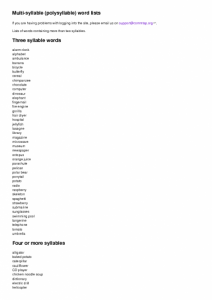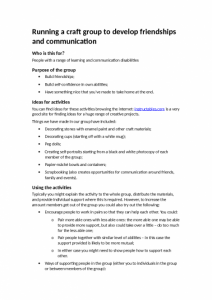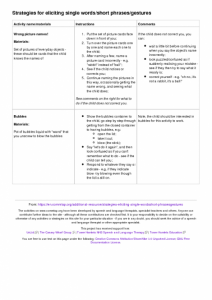Search
User login
Topic “Small group”
Contains activities or strategies suitable for a small group.
Multi-syllable (polysyllable) word lists
Lists of words containing more than two syllables.
Three syllable words
alarm clock
alphabet
ambulance
banana
bicycle
butterfly
cereal
chimpanzee
chocolate
computer
dinosaur
elephant
fingernail
fire engine
gorilla
hair dryer
hospital
jellyfish
lasagne
library
magazine
microwave
museum
newspaper
octopus
orange juice
parachute
pelican
polar bear
ponytail
potato
radio
raspberry
skeleton
spaghetti
strawberry
submarine
sunglasses
swimming pool
Activities for comprehension of concepts
Created 19 November 2015; updated 25 November 2015.
Running a craft group to develop friendships and communication
This provides suggestions for developing friendships and communication skills through running a craft group: particularly suitable for adults with a range of learning disabilities.
Created 21 July 2015.
Activities to develop early choice making between two items
| Activity/strategy name and materials required | How to do the activity | Key principles for doing the activity and comments |
|---|---|---|
| Choosing Between Toys - Desired and undesired toys, other objects | To begin with hold out a liked toy and a neutral object like a piece of paper - encourage the child to reach for what they want. When they can do this consistently hold out two toys - encourage the child to reach to choose. | Vary which side you hold the toys out to ensure that the child doesn't always reach in one direction. Occasionally, when the child has been reaching for what they want swap the toys around and see whether they still reach for the same one. Always label what they choose for example "snake ... you want the snake...". |
| Choosing Between Food - Two types of food | As above Always label what the child chooses or reaches for. For example: 'Oh, rice, mmmm' Make appropriate sounds like 'mmmmmm', 'yum yum' etc. |
Use a simple conversational structure over three turns
| Activity/strategy name and materials required | How to do the activity | Key principles for doing the activity and comments |
|---|---|---|
| How are you? | Two turns
Three turns Once two turns is mastered as above, move to three turns:
| For the three turns part, if a student makes a different response to the answer to their question than one of the possible responses on the prompt cards then that's fine as long as it is relevant. Otherwise, prompt them to make a response from one of the prompt cards. You could show different prompt cards, or you could show just one prompt card for the response in the last turn. |
| What have you been doing? | For this activity, a student using a contraction of the question is also fine (e.g. "What doing"), this activity is about creating turns in a conversation. | |
| Topic of interest - what have you got? Prompt cards for a "what have you got" conversation Set of pictures (e.g from Google) relating to a topic of interest to the student - e.g. Tesco, the park, Eastenders. |
Simple topic maintenance
| Activity/strategy name and materials required | How to do the activity | Key principles for doing the activity and comments |
|---|---|---|
| My interests |
| |
| Topic introduction
| ||
| Talk about it
| Optional:
| |
| Likes and dislikes Something to record the students responses on (e.g. paper/pen) which can later be used as a prompt; Soft ball or beanbag. | To make it harder, you can go around again asking for favourite drinks - so that everyone now has to remember a food and a drink for each student when they pass the ball (e.g "Tim - (you like) carrot cake and tea"). You could use favourite games, favourite places to go, etc. instead. | |
| What have you done today? Way of recording students responses - e.g. paper/pen, whiteboard/marker; Soft ball or beanbag. |
Strategies for eliciting single words/short phrases/gestures
Created 3 October 2014; updated 27 August 2015.
Strategies for eliciting single words/short phrases/gestures
| Activity name/materials | Instructions | Comments |
| Wrong picture names! Materials: Set of pictures of everyday objects - these should be cards that the child knows the names of |
Responds to who what and why
| Activity/strategy name and materials required | How to do the activity | Key principles for doing the activity and comments |
|---|---|---|
| The who/what/why sheet Sheet with 3 columns, one headed "who?", one headed "what?", one headed "why?" Brick cube 'Wh' word symbols You can make these resources using the Commtap Symboliser for PowerPoint. |
|
Responds to why questions
| Activity/strategy name and materials required | How to do the activity | Key principles for doing the activity and comments |
|---|---|---|
| Emotions picture cards Picture cards with emotions Optional - choice of pictures showing possible reasons - for example a picture of a boy who has fallen over to go with a picture of a boy who is crying. |
| |
| Why is it.... One or more pictures showing scenes - for example someone running away, a hot beach. Or... Pictures in a book. | ||
| A desirable and a non-desirable toy Two toys one desirable and one not. |
Responds to what questions
| Activity/strategy name and materials required | How to do the activity | Key principles for doing the activity and comments |
|---|---|---|
| Familiar picture books
|
| WARNING: it can become a habit to keep asking a child "what's that" whenever you see a picture (a phenomenom that might be called "What's that-ing") - so use in moderation - and, in other situations, try leaving long pauses for a child to tell you about a picture rather than asking a specific question. When the child is able to understand this question, you could try taking it in turns so that they get a go at asking you "what's that?". |
| Silly questions One or more of these:
... and if required: "What" symbol card |
Responds to who questions
| Activity/strategy name and materials required | How to do the activity | Key principles for doing the activity and comments |
|---|---|---|
| Familiar picture books
|
| Teach these concepts using repeated phrases and matching them as much as possible with the relevant symbol. Allow thinking time. Reward any attempts. |
| Photos of people One or more of these:
...and if required:
| You may need to give the child a language model before he/she can ask a 'who' question. | |
| Who is around? A situation where there are other people - for example in class, in the playground. "Who" symbol card if required. |
Activities to develop the pronouns 'him' and 'her'.
| Activity/strategy name and materials required | How to do the activity | Key principles for doing the activity and comments |
|---|---|---|
| Play with dolls A male doll A female doll 2 identical sets of items, e.g. toy food, counters, any small items.
| 1. Explain to the child that you are going to play a game that will help them learn 'him and 'her. 2. Set out the dolls and the items. Explain that you call the male doll 'him' and the female doll, 'her'. 3. Give you child instructions - e.g. give the cup to him, give the plate to her. 4. After a few turns, ask your child to give you an instruction using the word 'him' or 'her'. | Before woring on him/her, make sure your child can understand and use he/she - click here for activities to develop these concepts. |
| Him/her sorting game |
makes marks
| Activity/strategy name and materials required | How to do the activity | Key principles for doing the activity and comments |
|---|---|---|
| Imitates vertical strokes Writing tools and paper Washing up brush and bucket of water Sand tray Play dough | (1) Start by making big vertical strokes with a washing up brush and a pail of water outside on a fine day. Say "Down ... down" (2) Give the brush to the child (3) Reward any attempts to make a downward stroke for example with clapping, praise etc. (4) Follow this procedure in the sand or in a rolled out piece of play dough etc. (5) Use a chunky crayon (not too long) and a piece of paper. Say 'Down ......down.' (6) Give the crayon to the child (7) Reward success with praise or reward toys. (8) Use a ruler to make two vertical tramlines on the page and then help the child draw between the lines in a downward motion. (9) Draw two or three tramlines on a page well spaced - and see if the child can start at the top and draw down. (10) Draw big dots in a downward line and make the starting off dot big and red. Model for the child drawing a downward line roughly along this line of dots. You may need to start the child off and stop half way down the line for the child to complete. (11) Use different colours and writing tools to make the task more interesting. Reward attending to the task with social praise or a reward toy. |
Support Commtap to keep it online
Thank you for visiting Commtap.
Please read this message as it is extremely important.
- Visitor donations mean we can continue to host over 1,000 free activities to support speech, language, and communication development.
- Visitor donations mean we can continue to provide free resources to address a wide range of communication needs, including limited speech or language, interaction challenges, and needs associated with conditions such as developmental language disorder, autism, and cerebral palsy.
- Visitor donations mean we can continue to provide resources to support the work of speech and language therapists, teachers, teaching assistants, parents, and carers.
- Visitor donations mean we can continue to provide the free key word sign dictionary (bks.org.uk) which has over 2,000 Makaton and Signalong signs.
We know that not everyone is able to afford to pay to access these resources, however, if you can, please make a donation to keep the site going.
Thank you
Google ads on this page are provided by Google Adsense - and their presence does not imply any endorsement by Commtap. Report a problem with an ad on this page. Log in (for free) to avoid seeing Google ads.




